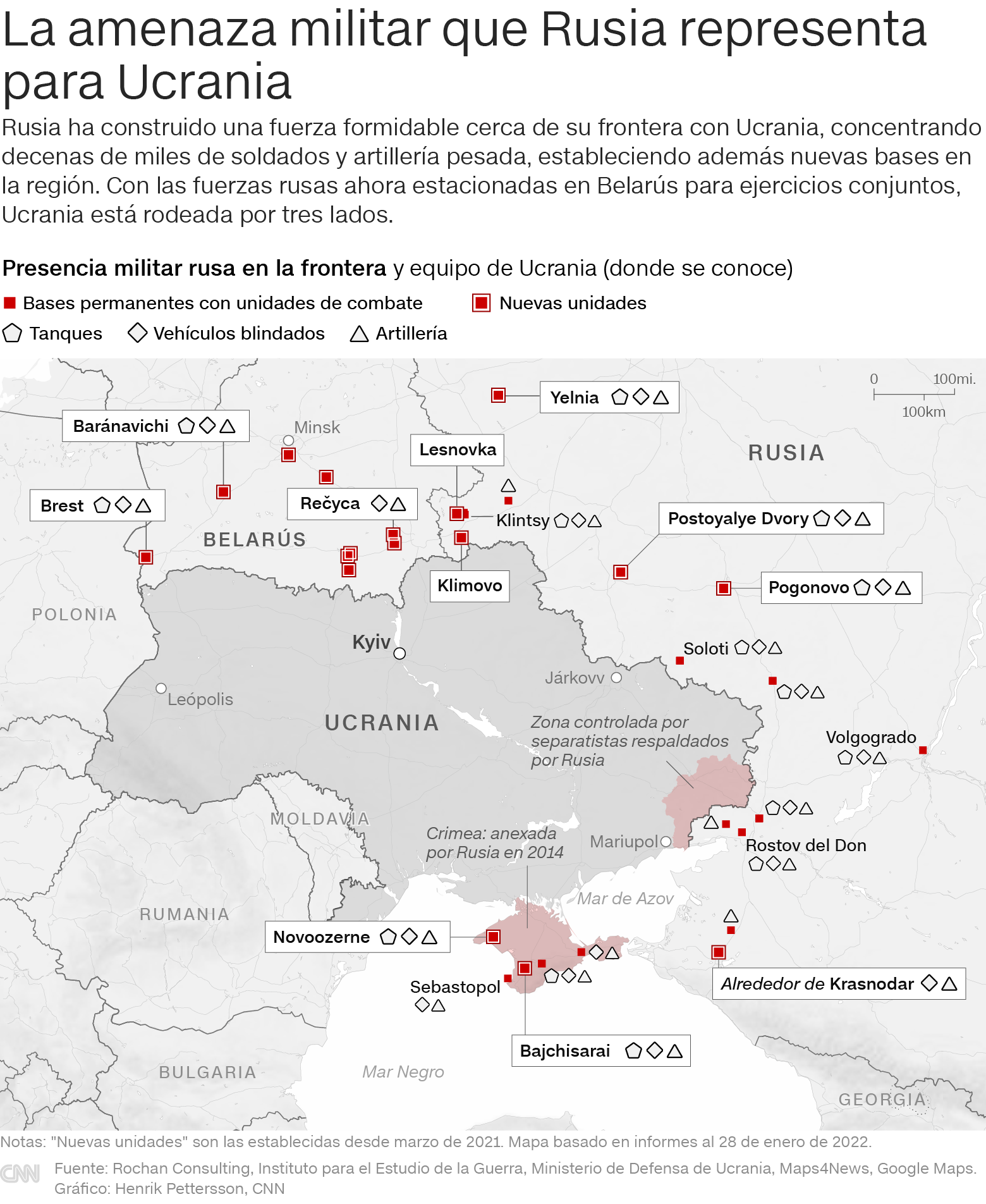(CNN Spanish) --
The conflict between Ukraine and Russia is at a critical moment: Russian President Vladimir Putin announced a special military operation to protect Donbas, the eastern region of Ukraine controlled by pro-Russian separatists.
These four maps illustrate the factors on the ground in Ukraine-Russia tensions.
The Kremlin has previously denied planning an attack and argued that NATO support for Ukraine is a growing threat on Russia's western flank.
Russia announces a military operation in Ukraine: latest news and live reactions
The control of the territory in Ukraine, the Nord Stream 2 gas pipeline, the mobilization of Russian soldiers on the border and the geopolitical pressure of NATO against the presence of Russia in the region come into play in the situation.
Control of the territory in Ukraine and Russia
Many of Russia's military bases are located in western Ukraine, where any threat to Russia is most likely, history suggests, to come from.
Russia's Defense Ministry has said it is holding "regular" winter military exercises in its southern region, parts of which border Ukraine.
advertising
Meanwhile, the eastern Ukrainian regions of Donetsk and Lugansk, bordering Russia, an area known as Donbas, has been under the control of Russian-backed separatists since 2014. Russian forces are also present in the area, to which Ukraine is attached. referred to as "temporarily occupied territories", although Russia denies this.
The front lines of the conflict have hardly moved in five years, but small-scale clashes and sniper attacks are frequent.
Russia was angered when Ukrainian forces first deployed a Turkish-made combat drone in October to attack a position of pro-Russian separatists.
Russia also has forces numbering in the tens of thousands at its huge naval base in Crimea, the Ukrainian territory it annexed in 2014. The Crimean peninsula, located south of the rest of Ukraine, is now connected by a road bridge with mainland Russia.
When did Ukraine belong to Russia and when did it break away?
The presence of Russian soldiers
As many as 100,000 Russian soldiers have remained gathered on the border with Ukraine, despite warnings from US President Joe Biden and European leaders about dire consequences if Putin goes ahead with an invasion.
And US intelligence results have estimated that Russia could begin a military offensive in Ukraine "as soon as early 2022."
The latest intelligence assessment from the Ukrainian Defense Ministry says that Russia has now deployed more than 127,000 troops near Ukraine, including some 21,000 air and sea personnel, transferred more operational Iskander tactical missiles to the border and increased its intelligence activity against the country.
The pipeline factor
Another important issue revolves around the energy supply.
Ukraine views the controversial Nord Stream 2 pipeline, which connects Russian gas supplies directly with Germany, as a threat to its own security.
Nord Stream 2 is one of two gas pipelines that Russia has laid underwater in the Baltic Sea, in addition to its traditional network of onshore gas pipelines that crosses Eastern Europe, including Ukraine.
Kyiv sees pipelines running through Ukraine as protection against a Russian invasion, as any military action could cut off the vital flow of gas to Europe.
US analysts and lawmakers have raised concerns that Nord Stream 2 will increase Europe's dependence on Russian gas and allow Moscow to selectively target countries like Ukraine with power outages without a broader European supply disruption.
Bypassing Eastern European countries also means that those nations would be deprived of lucrative transit fees that Russia would otherwise pay.
In May 2021, the Biden administration waived sanctions on the company behind Nord Stream 2, thus giving it the green light.
US officials say the move was taken in the interest of US national security, in an attempt to rebuild deteriorating relations with Germany.
In November, the United States imposed new sanctions on a Russia-linked entity and a vessel linked to Nord Stream 2. Some US senators called for more sanctions to prevent Russia from using the pipeline as a weapon;
Ukraine also called for tougher measures.
Does the Russian Nord Stream Pipeline Affect US Strategy in Europe?
4:56
NATO pressure
NATO, North Atlantic Treaty Organization, to give it its full name, is a non-aggressive European and North American defense alliance created to promote peace and stability and safeguard the security of its members.
NATO already had troops in eastern Europe before the recent rise in tensions with Russia, but has increased its presence there in recent weeks.
According to NATO, there are currently four battalion-sized multinational battle groups in Estonia, Latvia, Lithuania and Poland, on a rotating basis.
These battlegroups are led by the United Kingdom, Canada, Germany, and the United States.
NATO said on January 7 that they are "robust and combat-ready forces."
NATO Secretary General Jens Stoltenberg said the alliance is prepared to quickly bolster that presence by sending additional forces and capabilities to the area.
On January 28, Biden said he would move US troops to NATO allies in Eastern Europe "in the short term."
Prior to that announcement, the Biden administration had placed as many as 8,500 US troops on high alert for possible deployment to Eastern Europe.
More immediately, several NATO countries have begun sending arms and ammunition to Ukraine.
The United States has already shipped two arms shipments to Ukraine, including 300 Javelin anti-tank missiles, 800 bunker buster bombs and hundreds of thousands of rounds.
The United Kingdom has delivered new light anti-tank weapons to Ukraine, and the Czech Republic government agreed on Wednesday to donate more than 4,000 152-millimeter artillery shells.
READ MORE: What is NATO and when does it act?
With information Ivana Kottasová, Bryony Jones, Katharina Krebs, Anna Chernova, Alex Marquardt, Chandelis Duster, Radina Gigova, Nicole Gaouette and Barbara Starr.












/cloudfront-eu-central-1.images.arcpublishing.com/prisa/KMEYMJKESBAZBE4MRBAM4TGHIQ.jpg)


